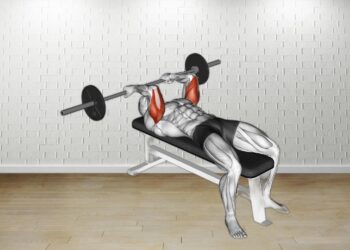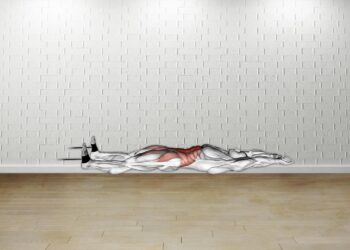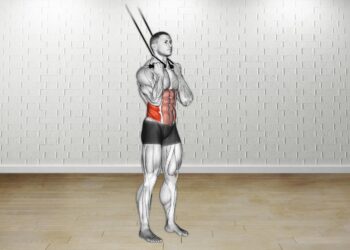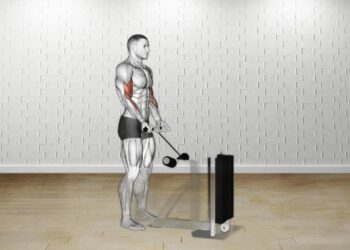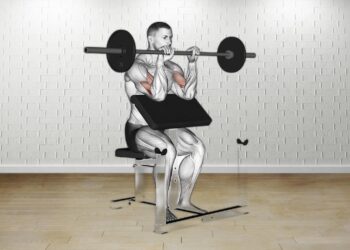Soviet soldiers supposedly used weighted Russian twists to build a battle-ready physique for the Cold War. If that’s true, we could see why… While used as a popular core training weapon, Russian twists are more of a total body workout.
While Russian twists receive mixed reviews among experts due to the lack of back support, it is possible to do them safely and benefit from this rotational powerhouse.
This article will guide you through proper Russian twists, explain the benefits, list the best variation and alternatives, and answer some FAQs.
Muscled Worked During Weighted Russian Twists
A complete ab killer, Russian twists target the oblique muscles but pick up the main abdominals along the way. Let’s talk about the anatomy of muscles involved during Russian twists.
Obliques
While a complete core exercise, Russian twists recruit the obliques to do their job which is trunk rotation and lateral flexion. Hence the obliques location on either side of the main abdominals, almost lateral on the trunk.
Rectus and transverse abdominis
Secondary to obliques during weighted Russian twists, rectus abdominis (six-pack abdominals) muscles are engaged, and the deeper transverse core muscles stabilize the trunk and spine.
Level Up Your Fitness: Join our 💪 strong community in Fitness Volt Newsletter. Get daily inspiration, expert-backed workouts, nutrition tips, the latest in strength sports, and the support you need to reach your goals. Subscribe for free!
Weak abdominals would make it hard to keep the trunk strong and maintain balance.
Hips
Hips muscles include everything from the buttocks to the muscles that attach the pelvis to the vertebrae. Just one look at the Russian twist and you know the hips have to do their part.
There are five muscles that flex the hips.
- Iliacus
- Psoas (major and minor)
- Rectus femoris
- Iliocapsularis
- Sartorius
Of the five hip flexors, the iliacus and psoas (together form the iliopsoas) are known as the most prominent. While the other three muscles bend the hips to 90 degrees, iliopsoas muscles lift the knee higher than 90 degrees (e.g., when you pull the knees into the chest).
Psoas – The psoas (pronounced so-as) connects from the lower back through the pelvis and attaches to the upper part of the femur (thigh bone). It contributes to lateral rotation of the thigh, lateral flexion of the trunk, postural support, and stabilizing the vertebral column during standing.
Iliacus – Iliacus rotates the hip, flexes the thigh, and supports upright posture.
Shoulders
No one thinks of Russian twists as a shoulder exercise. However, it kind of is… You’re supporting weight and moving it from one side of the body to the other using your arms.
If you go heavy enough, you can really tax the shoulders, and possibly see some delt gains. The anterior or front delts are active when with forward arm movement, while the lateral deltoids are active when the arms move laterally.
Weighted Russian twists are a decent upper-body workout!
Benefits of Weighted Russian Twists
If you focus on quality reps over quantity, weighted Russian twists are unbeatable for what they can offer in the way of core development and convenience. Here are the reasons why we favor this movement.
Powerful bodyweight/combination core workout
Weighted Russian twists rank atop the list of ab exercises with the highest potential (if done correctly). It’s one of the few variations that challenge your balance, core strength, spine stability, trunk mobility, and cardio fitness simultaneously.
It combines bodyweight resistance and the use of a weighted object to double-slam your core.
Absthetics
If you want to improve the look of your core, you’ll need to develop those muscles. Yes, you will get a powerful ab workout with heavy compound lifts like deadlift variations, squats, etc. However, specific isolation techniques can help to maximize the core’s musculature and function.
Time-efficient
Don’t have time to do an entire ab circuit but still want to hit all the core muscles hard? Weighted Russian twists are where it’s at.
Why weighted Russian twists are so beneficial is that they engage the deeper core muscles and strengthen the lower back due to the stability requirements of balancing on your butt.
Transferable to athletics
Balance, stability, trunk mobility, and core power are all components of Russian twists that carry over to athletic endeavors. We need to powerfully rotate to hit a tennis ball, wrestle, own the gridiron, or swing a bat.
But a strong core also helps us to transfer force efficiency during lifts, and to perform daily activities, and even some work tasks.
Give the lower body a workout
While not the primary goal, weighted Russian twists do require lower body and hip strength to keep the feet off the ground for the duration of sets. It’s a good way to keep your legs conditioned without resistance training.
How To Do Weighted Russian Twists
Now you’ll learn how to execute weighted Russian twists perfectly. We’ve included detailed step-by-step instructions and a video demonstration too.
Steps
- Choose a soft surface or one that’s comfortable.
- Sit on your butt, grab the weight in hand, and recline your torso back until your feet are comfortably a few inches above the floor. Your back should be straight, and at a roughly 75-degree angle to the floor.
- Take a breath in, breathe out, and brace your core muscles. Pull your shoulders down.
- Extend your arms down to either side while rotating your torso in the same direction.
- Now rotate your arms and torso in the opposite direction. Repeat for the desired number of repetitions or until you cannot complete any more reps with good form.
Check out the video demonstration of weighted Russian twists below.
Tips
- If you’ve never attempted weighted Russian twists, start with some of the progressions under the variations section below.
- Upper body rotation is the most crucial part of Russian twists.
- Keep your abs engaged throughout the entirety of each set.
- Use a challenging weight, but don’t go too heavy as it can place a lot of stress on your lumbar spine.
This Exercise:
-
Target Muscle Group: Obliques
-
Secondary Muscles: Rectus abdominis
-
Type: Core function, hypertrophy, strength
-
Mechanics: Isolation
-
Equipment: Weighted object
-
Difficulty: Intermediate
-
Best Rep Range:
-
Hypertrophy: 8-12
-
Muscles conditioning: 15+
-
Common Mistakes While Performing Weighted Russian Twists
Don’t waste your time with these bad Russian twist habits.
Level Up Your Fitness: Join our 💪 strong community in Fitness Volt Newsletter. Get daily inspiration, expert-backed workouts, nutrition tips, the latest in strength sports, and the support you need to reach your goals. Subscribe for free!
Russian taps…
While technology has made our lives easier in so many ways, requiring us to put in less effort during daily tasks, the same should never apply to training. It doesn’t work.
Yet nowadays, we adopt the same philosophy, following the advice of fitness instructors who try to dumb exercises down or make them more time efficient.
Russian taps, ahem sorry twists, are victim to quantity over quality. Nowadays, people omit the oblique twist entirely and just move their arms from one side to the other.
To benefit from Russian twists and engage the oblique muscles, you actually need to twist your trunk and engage the core muscles.
Using too much weight
You would assume people know their limits but it’s not the reality, unfortunately. Straining and using too much resistance can cause a rounded and sore back and it’s not a good look.
Start out with something that’s very manageable. Focus on good form first, and the weight second. Russian twists are not supposed to be a max lift, and you don’t want to overstress the spine.
Variations and Alternatives of Weighted Russian Twists
Here are some of the best rotational and oblique exercises similar to weighted Russian twists.
Heels touching Russian twists
When first introducing weights to Russian twists, it’s beneficial to start with a few progression techniques.
For starters, keep your feet on the floor. This will get you used to the movement. You can also hold the weight near your chest and perform rotation. But don’t move the weight toward the floor just yet.
After you gain more confidence, begin to alternate moving the weight from one side to the other, but still keep your feet on the floor.
Here’s a video demonstration of both variations.
Cable standing Russian twists
Standing on your feet to perform weighted Russian twists trains you to function as you would out in the real world. It’s especially applicable to athletic movement where you need to activate the kinetic chain and transfer force efficiently.
Steps:
- Attach a D-shaped or similar handle to the cable pulley. Slide the pulley to about mid/lower chest height.
- Stand sideways to the weight stack and grab the handle with the nearest hand, then place the opposite hand on top. Then, keeping your elbows straight or slightly bent, step away from the machine to create tension in the cable.
- Adopt an athletic, shoulder-width stance and brace your core.
- Keeping your shoulders and arms rigid, use your oblique muscles to rotate your torso 180 degrees.
- Return to the starting position and repeat.
- When you’ve completed all reps, turn to the opposite side, and repeat, alternating for the desired number of sets. Make sure that you do both sides.
Tips:
- No access to a cable machine? You can also attach a resistance band to a chest-level object to replicate this variation.
- Try this exercise from a half-kneeling position, to emphasize core engagement.
Cable Russian twists W/ stability ball
The primary example used for the purpose of this training guide is a free weight (Dumbell, medicine ball, etc) Russian twist. However, the cable variation with a stability ball is also a powerful way to load Russian twists.
The main differences are that you’re balancing on a stability ball, using cables attached to a machine, and only twisting to one side at a time.
Steps
- Attach a single-grip handle to the cable pulley high enough to where you can fully extend your arms and the pulley is in line with your fists or higher.
- Place the ball next to the pulley and lie on it to where your chest is in line with the pulley.
- Grip the handle with the closest hand, extend your arm directly over your chest, then place your other hand on top to get a firm grip.
- Keep your hips high, tighten your midsection, and rotate away from the machine using your core muscles. Your arms should remain straight and extended in the same position throughout the exercise. You’re only using your core to rotate your body.
- Slowly return to the starting position, resisting the weight from pulling you back too quickly.
- Complete the desired number of reps and then repeat on the other side.
Tips
- Use a quality exercise ball, and make sure it’s properly inflated before each use.
- You can also perform stability ball Russian twists using just your body weight.
Seated broomstick twists
Broom sticks are a very old-school exercise, endorsed often by famous trainer Jeff Cavaliere, who boasts over 13 million subscribers on his YouTube channel (Athlean X).
Therefore, if Cavaliere thinks they’re a beneficial movement, so do we.
Note: It may appear to be an easy exercise, however, if you’ve never done it then prepare to be surprised by how challenging it really is.
Steps
- Grab a broomstick, PVC tubing, or something similar. Place the bar behind your head and rest it on your traps. Your hands should be wider than shoulder-width distance apart, with the forearms vertical or parallel to each other.
- Sit at the edge on the narrow part of the bench, where the head normally is when you perform most exercises.
- Round the spine by hunching your upper body forward.
- Lean back slightly to create some resistance, and tilt your pelvis back.
- Keep your head up, and slowly rotate one elbow toward the opposite knee. Squeeze your obliques hard. Now twist in the other direction.
Fast forward to the 3:55 mark to watch Cavaliere explain proper broomstick twist form, while his assistant demonstrates the exercise.
Bicycle crunches
Like weighted Russian twists, bicycle crunches can either be one of the best rotation exercises, or a waste of time. The key is to actually rotate your upper body, and not just tap your elbow to the opposite knee.
Steps
- Lie on your back, and place your fingertips behind your head close to the ears. Bring your knees up so your upper legs are vertical.
- Tense your core muscles.
- Now rotate your torso to the left and pull your left knee in at the same time. Try to touch your right elbow and left knee. Squeeze the oblique muscles as you crunch.
- Rotate to the right and bring your right knee to the left elbow.
Tips
- Think about touching your shoulder to the opposite side knee. This will help you to remember trunk rotation which is crucial for effective bicycle crunches.
- Breathe in as you touch an elbow and knee. Inhale as you rotate to the other side, and again exhale as your elbow and knee touch.
- Keep your core braced throughout the exercise.
Landmine 180s
An absolute savage exercise, landmine 180s include core rotation but you can load them much heavier.
The only drawback is you need a dedicated landmine setup, a barbell, and hole in the wall, or you have to get a little creative unlike weighted Russian twists, which only require a type of weighted object (many options).
Related: The 19 Best Landmine Exercises for Building Muscle Mass and Strength
Steps
- Start with just the bar or load the desired amount of weight onto the free end of the barbell.
- Plant both feet on the floor about shoulder width apart and point the toes slightly outward.
- Bend down and grab the end of the bar with both hands, then stand up and extend your arms forward.
- Now lower the bar down to either side, while keeping the top arm extended and the bottom arm bent. Slightly rotate your torso in the direction of the bar as it’s pulled down.
- Explode the weight up overhead to the starting position and then lower it to the other side. Remember to keep the top arm straight and the bottom arm extended. This changes each time the bar is lowered to either side.
Check out our full guide to landmine 180s here.
Floor wipers
A devastating exercise for your core muscles (in a good way), floor wipers are not for the faint of heart. In fact, it was one of the handpicked exercises used by celebrity trainer Mark Twight to help prepare actors to play ancient spartans in the iconic 2006 film ‘300’.
Steps
- Lie on your back with your legs straight. Press and hold a barbell over your chest loaded with a manageable but challenging weight.
- Brace your core and raise your legs, touching your feet to the right side of your barbell.
- Lower your feet back to the floor and then raise your legs to the left.
- Continue lowering and raising your legs, alternating sides rep by rep, for the duration of your set, keeping your arms straight and vertical throughout.
Tip/s
- Try hanging floor wipers for a more advanced variation. The weight of your legs and high arcing motion creates a greater challenge than lying bodyweight wipers.
Read the full floor wipers exercise guide here.
FAQs
What type of weights can I use for weighted Russian twists?
Don’t overthink it. Anything from a medicine ball to a dumbbell, kettlebell, or some type of evenly weighted object will do.
How much weight should I use for weighted Russian twists?
Choose a weight that allows you to feel challenged during Russian twists, but not so heavy that you’re straining. Typically, a range of 8-25 challenging reps will allow you to benefit from the exercise, alternating the weight load on different days.
However, how much weight you use ultimately depends on strength ability, experience, and goals.
What are the optimal reps for weighted Russian twists?
Use a weight that will challenge you anywhere from the 8-25 rep range, alternating lighter weight on one day and heavier on another.
Are weighted Russian twists bad for your spine?
They can be if you have a weak core, bad form, and/or use too much weight. Either of these bad habits can cause a lot of stress on the lumbar spine.
Can anyone do weighted Russian twists?
No way!
We don’t recommend them for beginners with little training experience, people who are very overweight, and those with back pain or issues.
What type of weights can I use for weighted Russian twists?
Don’t overthink it. Anything from a medicine ball to a dumbbell, kettlebell, or some type of evenly weighted object will do.
How much weight should I use for weighted Russian twists?
Choose a weight that allows you to feel challenged during Russian twists, but not so heavy that you’re straining. Typically, a range of 8-25 challenging reps will allow you to benefit from the exercise, alternating the weight load on different days.
However, how much weight you use ultimately depends on strength ability, experience, and goals.
What are the optimal reps for weighted Russian twists?
Use a weight that will challenge you anywhere from the 8-25 rep range, alternating lighter weight on one day and heavier on another.
Are weighted Russian twists bad for your spine?
They can be if you have a weak core, bad form, and/or use too much weight. Either of these bad habits can cause a lot of stress on the lumbar spine.
Can anyone do weighted Russian twists?
No way!
We don’t recommend them for beginners with little training experience, people who are very overweight, and those with back pain or issues.
Wrapping Up
There’s a reason Russian twists have adopted so many names. Everyone wants credit for this core killer that’s so darn effective! However, crappy form and failure to rotate the torso make it nothing more than a subpar shoulder builder and pain in the back.
But the good news is you can build up to weighted Russian twists by utilizing some of the variations, or you may prefer one of the alternatives instead. You cannot go wrong with any, but Russian twists do have a lot of advantages.
This guide should serve you well in identifying common mistakes and determining the appropriate weight load.
Interested in measuring your progress? Check out our strength standards for Deadlift, Bicycle Crunch, Squat, and more.



